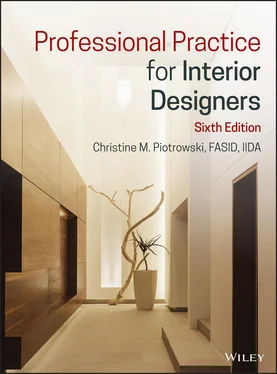Christine M. Piotrowski - Professional Practice for Interior Designers
Здесь есть возможность читать онлайн «Christine M. Piotrowski - Professional Practice for Interior Designers» — ознакомительный отрывок электронной книги совершенно бесплатно, а после прочтения отрывка купить полную версию. В некоторых случаях можно слушать аудио, скачать через торрент в формате fb2 и присутствует краткое содержание. Жанр: unrecognised, на английском языке. Описание произведения, (предисловие) а так же отзывы посетителей доступны на портале библиотеки ЛибКат.
- Название:Professional Practice for Interior Designers
- Автор:
- Жанр:
- Год:неизвестен
- ISBN:нет данных
- Рейтинг книги:4 / 5. Голосов: 1
-
Избранное:Добавить в избранное
- Отзывы:
-
Ваша оценка:
- 80
- 1
- 2
- 3
- 4
- 5
Professional Practice for Interior Designers: краткое содержание, описание и аннотация
Предлагаем к чтению аннотацию, описание, краткое содержание или предисловие (зависит от того, что написал сам автор книги «Professional Practice for Interior Designers»). Если вы не нашли необходимую информацию о книге — напишите в комментариях, мы постараемся отыскать её.
Professional Practice for Interior Designers
Professional Practice for Interior Designers — читать онлайн ознакомительный отрывок
Ниже представлен текст книги, разбитый по страницам. Система сохранения места последней прочитанной страницы, позволяет с удобством читать онлайн бесплатно книгу «Professional Practice for Interior Designers», без необходимости каждый раз заново искать на чём Вы остановились. Поставьте закладку, и сможете в любой момент перейти на страницу, на которой закончили чтение.
Интервал:
Закладка:
List three expectations you have concerning your first job. Why do you feel these are reasonable for an entry‐level designer?
HOW DO DESIGNERS WORK?
There are many different ways to work in the interior design field. Some of these will appeal to your creative side and some to technical prowess. These descriptions begin our clarification of the wide variety of career opportunities in the interior design profession. A discussion of career specialties follows this chapter and is titled Professional Options. These brief descriptions paint a broad‐stroke picture of how interior designers may work.
“On‐the‐Boards” Responsibility
The term on the boards is a traditional one referring to the performance of the tasks of doing a project. This would be someone who spends a significant amount of time preparing space plans, construction drawings, and other design documents utilizing a drafting board. Of course, today the on‐the‐boards designer is working with a computer rather than paper‐and‐pencil drawing and drafting.
These designers are involved in all phases of a design project. This designer can be involved in any of the specialty areas of design. Another term for this type of specialty is designer/specifier, a term that also refers to interior designers who prepare all the design elements of a project and specify the needed products, but rarely sell merchandise.
An interior designer in this situation could be working in an independent design firm, an architectural office, or several other environments not focused on selling products. They will be compensated either by a salary or hourly rate. Many designers who sell products may also be on the boards, as they must prepare plans and other documents in order to sell merchandise.
Selling Responsibility
Many positions in interior design require a certain amount of selling responsibility. A designer's selling responsibility starts with the job interview with an employer. Designers must then “sell” themselves to prospective clients as they attempt to be hired by the client. Selling also occurs as designers sell their design ideas to the client as the project progresses.
For some, selling becomes the major responsibility, overshadowing planning and design tasks. Many designers who work in retail specialty stores (such as lighting fixture stores, department stores, and office furnishings dealerships) find that the ability to sell is primary to preparing plans and specifications. Depending on the role one is hired for, this may also be true for an employee of a residential furniture store. In many cases, designers working in a store environment may be limited as to what they may sell to the client based on the products carried or featured by that store.
Selling responsibility positions are usually compensated by a commission on each sale rather than a salary.
Freelance Consulting
Designers who have gained experience in interior design may decide to become freelance designers/consultants. It could be argued that a sole practitioner designer is a freelance designer. For our purposes, however, this discussion refers to designers who work irregular hours, not necessarily full time, and not directly for end‐user clients such as a home owner or commercial space owner.
A freelancer might work in one or more specialty areas of interior design. They might provide specialized services to other designers such as rendering. She might provide consulting to designers concerning lighting design, or commercial kitchen design, or other highly technical design areas.
Freelancers contract with the designer/client for whom they will do work and are not considered employees of the design firm. Their compensation could be an hourly, daily, or per‐job fee. Depending on experience, such a designer might work for more than one client at the same time and even do more than one kind of project at a time.
This type of freelance consultant enjoys variety and does not want to work full time. The Internet allows freelancers to work on a global basis if they so choose. It is unusual for the freelance consultant to have employees. Drawbacks include an irregular income, as work comes at an unsteady pace. These individuals must also pay their own working benefits, taxes on income, and have the self‐discipline to work to the extent required for each consulting job.
Management
Interior designers also work as managers in design industry businesses. An individual might be the design director with an interior design or architectural office, supervising a design staff. She might be the manager of the design staff in a furniture store, or the manager of a specialty store. She might have a management position as a project manager for a construction company or development company. These are only a few examples of management positions.
The person who is considering management positions in interior design will be required to have extensive experience in one or more specialty areas of interior design. A business background based on experience in the profession, along with educational background in management, is also helpful—if not required—for these positions.
Managers supervise the design staff, assign the work in the office, prepare reports to ownership, and meet with clients. Design office managers are often involved in marketing to obtain new clients. Depending on the size of the firm and design staff, the manager may find it necessary to limit his or her personal design involvement in projects. The larger the firm is, the more the manager will need to attend to various administrative activities rather than being involved in creative work.
TYPES OF WORK ENVIRONMENTS
Interior designers can work in many settings or work environments and do many different kinds of jobs. Numerous opportunities exist beyond the stereotypical work in “a residential store” or a “commercial design office.” This section begins with the most typical starting locations for entry‐level interior designers. Positions that require experience or perhaps additional education are discussed at the end.
These descriptions are very general and actual experiences and settings will vary. Size of the firm, geographic location, design specialty, and business philosophy of ownership all affect the work environment and experience.
Independent Design Firm
An independent design firm may be a one‐person design studio or a large firm that has dozens of employees. It is very common for interior designers to start their businesses working alone with no full‐time employees; these would be considered independent interior design firms.
A key to the concept of defining the firm as “independent” is that typically it has no affiliation with a particular manufacturer's product. Some, however, have a limited amount of showroom space more for the purpose of display than direct sales off the floor.
In a small firm, the owner always takes the lead in developing relationships with clients and marketing in general. Yet, it is also common for designers in some small firms to be expected to obtain new clients, and manage projects with minimum assistance from the owner. The owner of the smaller firm also does a lot of project work in addition to managing the firm.
The larger firms will have various management and staff levels. Client contact is usually the responsibility of the owner, the senior designers, or possibly a marketing manager. Senior designers are primarily responsible for managing projects, and they often supervise a team of designers and support personnel during the course of the project. In some firms, there are also individuals who have many specialized job functions, such as specification writers and renderers, who can free the project designers from such activities.
Читать дальшеИнтервал:
Закладка:
Похожие книги на «Professional Practice for Interior Designers»
Представляем Вашему вниманию похожие книги на «Professional Practice for Interior Designers» списком для выбора. Мы отобрали схожую по названию и смыслу литературу в надежде предоставить читателям больше вариантов отыскать новые, интересные, ещё непрочитанные произведения.
Обсуждение, отзывы о книге «Professional Practice for Interior Designers» и просто собственные мнения читателей. Оставьте ваши комментарии, напишите, что Вы думаете о произведении, его смысле или главных героях. Укажите что конкретно понравилось, а что нет, и почему Вы так считаете.












